European Architectural Influence in Dubai's Real Estate
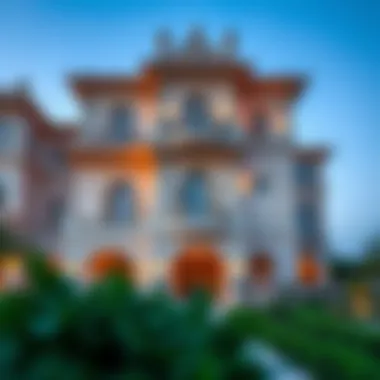
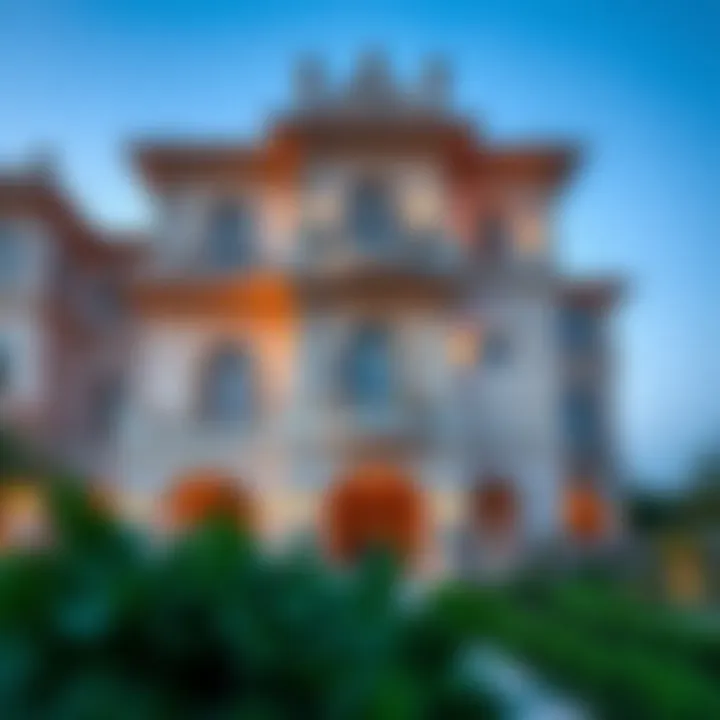
Intro
Dubai, a city often characterized by its towering cranes and lavish lifestyle, holds a unique position where modernity meets a tapestry of global influences. Among these influences, European architectural and design aesthetics have carved a significant niche, shaping the luxurious real estate market we see today.
This phenomenon is not merely about blending brick and mortar; it is a rich dialogue between cultures, bringing forth styles from regions known for their architectural prowess. Whether it’s the contemporary elegance of Italian design or the classical charm of French architecture, each influence adds layers to Dubai's already eclectic skyline.
In this narrative, we will scan through various neighborhoods that resonate with European ethos, discussing how the distinct styles impact the market and what opportunities lie within for prospective buyers and investors. Understanding these nuances is crucial, not just for navigating the property landscape but also for immersing oneself in the rich cultural experiences that Dubai offers.
We will explore the aesthetics, the practicalities of purchasing property in such a competitive market, and what the integrated European styles mean for the collective identity of Dubai. As the city continues to grow, so too does the allure of its European-infused properties, making them a focal point for many seeking not just a home, but a vibrant cultural experience.
Let’s delve deeper into the properties that stand as testaments to this union of Dubai and Europe.
Preamble to European Style in Dubai
Exploring European style in Dubai involves diving deep into a fascinating blend of cultures, architectures, and influences that have shaped the luxury real estate landscape of this vibrant city. Understanding this topic opens up a treasure trove of insights for real estate investors, expatriates, and families looking to immerse themselves in a cultural tapestry that fuses the old with the new. European design, with its heritage and elegance, serves as a significant element in Dubai’s modern development, making it essential to grasp its nuances.
Definition of European Style
European style encapsulates a myriad of architectural designs, artistic expressions, and lifestyle choices that have evolved across different countries on the continent. It often brings to mind grandiose structures, intricate detailing, and a certain je ne sais quoi that resonates throughout history. This style is not limited to merely aesthetic values; it blends functionality and beauty, encapsulating the essence of European living. From the delicate curves of Baroque architecture to the clean lines of contemporary minimalism, European style offers a spectrum of possibilities that contribute to Dubai’s varied architectural landscape.
To effectively discuss European style in the context of Dubai, it’s crucial to highlight several key elements:
- Consistency in Aesthetic: Many buildings showcase ornamental features typical in Western architecture, such as arched windows and decorative facades.
- Quality of Craftsmanship: European influences often translate to higher quality finishes and materials used in construction. This adherence to quality is not just a trend; it’s a hallmark of the desirability in real estate.
- Timelessness: European styles often resist the pressures of fleeting trends; instead, they favor designs that stand the test of time.
Historical Context
To understand the rise of European style within Dubai, one must consider the historical backdrop that paved the way for such influences. The late 20th century marked a turning point for Dubai, a time when the city began transforming into the global metropolis that it is today. Increased globalization, along with substantial economic growth fueled by oil, attracted numerous expatriates and investors from Europe seeking new opportunities.
As opportunities multiplied, architects and designers started to flock to Dubai, bringing with them rich European design traditions. This melding of cultures gave rise to a unique architectural scene characterized by an eclectic mix of influences. Notably, developments like the Burj Al Arab and Palm Jumeirah showcase the innovative spirit while embracing elements of European aesthetics.
Furthermore, the historical ties along trade routes and the influx of international events have continuously shaped Dubai’s landscape.
In summary, European style is not merely a decorative choice in Dubai but a reflection of its historical context and a response to global influences. This complex evolution invites real estate investors, expatriates, and families to explore living in spaces that offer more than just luxury; they present a way of life steeped in cultural appreciation and architectural heritage.
Architectural Influence of European Design
The influence of European design in Dubai's architectural landscape is not just a trend, but a significant shift that reflects the city's global aspirations. European styles bring a certain elegance and sophistication that resonate well with the cosmopolitan vibe of Dubai. With a growing population of expatriates and affluent buyers, the demand for properties that feature European aesthetics has skyrocketed. By integrating these styles, Dubai not only enhances its skyline but also embodies a unique blend of cultures. This architectural interplay creates a sense of familiarity and luxury for many residents and investors.
Key Architectural Styles
Classical Architecture
Classical Architecture represents a time-honored tradition that has shaped buildings for centuries. Characterized by symmetry, columned facades, and elaborate detailing, this style is often viewed as a hallmark of sophistication. In Dubai, the presence of Classical Architecture can transport one to a world merging the ancient with the modern, thereby enhancing the narrative of luxury and grandeur.
A notable feature of Classical Architecture is its use of columns, which serve not only a structural purpose but add a visually stunning element to any building. This classic style is popular within the luxury market, providing a sense of permanence and stability. However, its drawbacks include higher construction costs and the need for skilled artisans familiar with these methods, which can slow down project timelines.
Modern Minimalism
Emerging as a counterpoint to more decorative styles, Modern Minimalism emphasizes simplicity and functionality. This approach champions clean lines, open spaces, and an uncluttered aesthetic that appeals to many investors seeking a contemporary lifestyle. The key characteristic of this architectural style is its rejection of ornamentation; rather, it values the beauty of materials and form.
The benefit of Modern Minimalism in Dubai is its adaptability to various environments while promoting a sense of calm and order. Unique features like floor-to-ceiling windows flood spaces with natural light, enhancing the living experience. However, minimalism can sometimes be perceived as stark or cold, which may not satisfy everyone’s taste.
Art Deco
Art Deco stands as a celebration of artistic and architectural innovation from the early 20th century. In Dubai, this style is characterized by its geometric shapes, bold colors, and lavish ornamentation, making it a vibrant addition to the city’s diverse architectural landscape. Its appeal lies in the ability to evoke the glamour of a bygone era while offering a modern touch.
The distinct feature of Art Deco is its visual versatility, which encourages creativity in design without sacrificing functionality. This makes it a favorite for hotels, boutiques, and high-end residences. However, its ornate nature can also lead to heavier maintenance requirements and possibly higher renovation costs, posing a challenge for long-term sustainability.
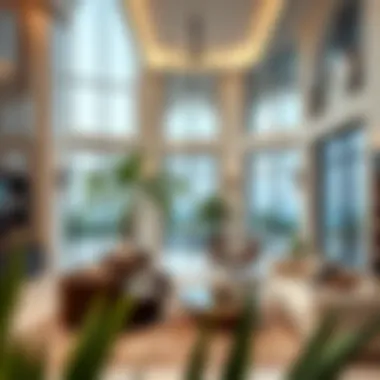

Famous European Architects in Dubai
Various European architects have made their mark in Dubai, infusing their vision into the city's skyline. For instance, the classical influences of Spanish architect Santiago Calatrava can be seen in the soaring towers that define the landscape. Renowned for his innovative approach to blending art and engineering, his works serve as a testament to the city’s commitment to architectural excellence. Some others include Richard Meier and Zaha Hadid, whose iconic designs have reshaped perceptions of contemporary architecture.
"Dubai is not just a city; it's a canvas for architectural experimentation and a hub for the creative elite."
This architectural legacy enhances the appeal of the local market, especially for investors looking for properties that not only offer luxury but also tell a story through their design. The integration of these unique styles reflects the city’s dynamic evolution, providing both challenge and opportunity in a landscape driven by rapid growth.
Neighborhoods Showcasing European Influence
The neighborhoods in Dubai that reflect European influence showcase a fascinating blend of aesthetics, lifestyle, and investment potential. These areas are not just about buildings; they embody a tangible mix of cultural expression and architectural flair that appeals to real estate investors, expatriates, and families alike. Each neighborhood presents unique characteristics that highlight the infusion of European style into the city's landscape.
Palm Jumeirah
Palm Jumeirah is, without a doubt, one of Dubai's crown jewels, boasting a shape that's recognizable from miles away. The area's allure lies not only in its opulent villas and beachfront properties but also in the sophistication of its design. Influenced heavily by European coastal towns, the architectural styles here range from Mediterranean villas to modern flats that echo European sensibilities. Residents enjoy access to beautiful beachside promenades and luxury retail outlets that mirror the charm of cities like Nice and Barcelona.
Benefits of Palm Jumeirah include:
- Luxury Living: High-end amenities and spacious layouts suitable for families or those seeking exclusivity.
- Scenic Views: Properties offer breathtaking views of the Arabian Gulf, reminiscent of lavish coastal retreats in Europe.
- Community Feel: Despite its stature, there's a close-knit community vibe, coupled with cultural celebrations that attract a diverse populace.
The integration of European-style architecture makes Palm Jumeirah not just a place to live, but a vibrant community ripe with lifestyle opportunities.
Jumeirah Village Circle
Jumeirah Village Circle (JVC) presents a different yet equally compelling aspect of European influence in Dubai. This neighborhood boasts well-planned streets lined with stylish townhouses and apartments that borrow from various European designs. Although more contemporary, elements of Spanish and Italian architecture are evident, creating an appealing visual narrative.
Unlike some of the more opulent neighborhoods, JVC offers a mix of affordability and accessibility, making it attractive to a younger demographic and families.
Considerations for JVC include:
- Affordability: Compared to Palm Jumeirah, property prices are more accessible, catering to a wider range of buyers.
- Amenities: Parks, schools, and retail options abound, ensuring all daily necessities are within reach, appealing for families.
- Transport Links: Proximity to major roads and public transport options enhances the convenience for residents who commute.
This neighborhood is a testament to how European design can be adapted to create efficient, functional living spaces that do not sacrifice aesthetics for practicality.
Dubai Marina
Dubai Marina is often hailed as the epitome of modern urban living, with its skyline punctuated by skyscrapers that hint at European architectural inspiration. Prominent features include yacht berths, waterfront promenades, and stylish dining establishments, all echoing the vibrancy of cities such as Monaco or Porto. The layout of the marina itself is a marvel, blending luxury living with recreational spaces.
This area is particularly popular among expatriates and young professionals, making it a melting pot of different cultures.
Highlighting attributes of Dubai Marina:
- Vibrant Lifestyle: A plethora of entertainment options, from fine dining to entertainment venues, replicates that cosmopolitan feel found in many major European cities.
- Diverse Community: It's an ideal space for both single professionals and families, fostering a high-quality living environment.
- Investment Appeal: Properties in Dubai Marina maintain strong market values, making it a hotspot for property investment.
With its blend of luxurious amenities and emphasis on community, Dubai Marina stands out as a prime location for those looking to experience a slice of European sophistication in the heart of the Middle East.
Real Estate Trends Reflecting European Style
The real estate landscape in Dubai is a vibrant tapestry woven from diverse influences, yet the European touch cannot be overstated. From the architectural flair to interior design nuances, European style casts a long shadow across the market. Understanding these trends is crucial for anyone looking to invest in Dubai's luxury real estate sector. The unique blend of cultural essence and sophisticated design not only enhances the aesthetic appeal but also boosts property values and investor interest.
Luxury Market Dynamics
In Dubai, the luxury real estate market is akin to a merry-go-round, with players constantly adjusting to whims and fancies. Here, European design elements have become incredibly sought after, offering an ostentatious allure that elevates living spaces. Properties with European characteristics, such as high ceilings, expansive windows, and intricate moldings, are perceived as more prestigious.
- Buyers' Preference: The fancy for European-styled homes has shown a noticeable spike among expatriates and affluent buyers. Many envision luxury that combines practicality with aesthetics. They often seek residences that reflect their individual style while also meeting global standards. The trend hinges on not just visual beauty but also on quality craftsmanship.
- Market Pricing: Interestingly, homes flaunting refined European architecture can command higher prices. According to recent reports, properties in neighborhoods like Dubai Marina or Palm Jumeirah that exhibit European style command a premium, turning heads and attracting wealthy investors who see not just a living space but a status symbol.
- Amenities Influence: Beyond mere architectural flair, the luxury market increasingly emphasizes amenities that resonate with European lifestyles—think gourmet kitchens reminiscent of Parisian apartment layouts or opulent bathrooms echoing spa retreats found in Swiss chalets. These nuances significantly contribute to the overall value perception.
Navigating these dynamics can be a bit like trying to thread a needle. It's essential for buyers and investors to grasp the nuances of the luxury market and how European elements fit within it.
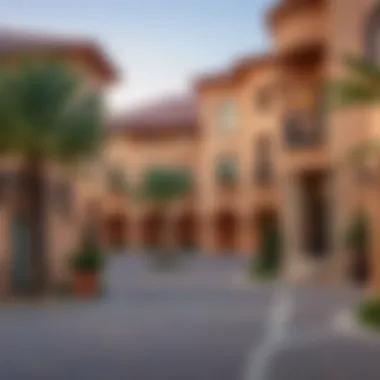

Sustainable Design Practices
Embracing European design is not just about aesthetics; it intertwines home building with sustainable practices. Many developers have caught onto this trend, realizing its dual benefit: appeal to the environmentally-conscious buyer and reduce operating costs.
- Eco-friendly Materials: Developers are now opting for sustainable materials reminiscent of European designs—bamboo flooring, recycled glass, and high-efficiency insulators are becoming commonplace. The focus is also shifting towards sourcing materials locally to minimize the carbon footprint while ensuring longevity in construction.
- Energy Efficiency: Implementing energy-efficient systems, like solar panels inspired by European models, holds much appeal. Such systems not only help in reducing energy bills but also align with the global shift toward sustainable living. Homebuyers are increasingly aware of the importance of energy consumption, hence, characteristics like smart home technology that controls lighting, climate, and security are in high demand.
- Landscaping: The charm of European gardens, often filled with indigenous plants that require less water, has started to be mirrored in Dubai's residential designs. This not only adds aesthetic value but aligns with Dubai’s sustainability goals, helping residents reduce their water usage.
Adopting these sustainable practices reflects a broader cultural shift—where the emphasis is not simply on luxury but living harmoniously with the environment. Investors keen on eco-conscious trends can find a fertile ground in Dubai, where European style meets contemporary sustainability aspirations.
"Sustainability isn't just a trend; it's the future of living in urban landscapes like Dubai."
The fusion of luxury with sustainability keeps the doors wide open for European influences to dominate the real estate market in the years to come. As more people lean towards homes that embody both lavishness and mindfulness, the prospects for growth in this niche look promising.
Cultural Integration and Community Expectations
Cultural integration plays a critical role in shaping neighborhoods that blend European styles with Dubai's local culture. This dynamic interaction fosters a sense of belonging among diverse communities, especially for expatriates who may feel adrift in a vastly different environment.
When European architectural influences seep into the local design ethos, something remarkable happens. It creates spaces that resonate with both cultural roots and contemporary aesthetics, effectively bridging the gap between tradition and modernity. The blend is not merely about aesthetics; it's about creating an inclusive environment for everyone, reinforcing societal cohesion.
Cultural Sensitivity in Design
Cultural sensitivity in design is not just about ticking boxes; it’s a nuanced dance that respects local customs while embracing foreign styles. Designers are now more aware than ever that a structure isn't just a building. It carries stories, memories, and the essence of the community it serves. This mindful engagement leads to designs that speak to the spirit of both the UAE’s rich heritage and European formality.
- Understanding the Locale: Knowing the cultural landscape of Dubai requires delving into traditions and societal norms. For instance, incorporating elements that reflect Arabic aesthetics, such as intricate tile work or traditional courtyards, can create harmony in a predominantly European-influenced neighborhood.
- Respect for Local Customs: An example would be a residential community that dedicates spaces for communal activities, crucial in Middle Eastern culture, while maintaining European design aesthetics in facades and interiors.
This cultural sensitivity often results in a design that is distinctive yet familiar. It invites both European expats and local families to find common ground, enhancing community connections.
Community Enrichment through Design
Design has the power to foster community interaction and enrich lives. This isn’t merely functional; it’s transformative. When the design incorporates open parks, communal gathering spots, and vibrant street façades, the results can be profound.
- Fostering Social Interaction: Areas designed with communal spaces encourage neighborly interactions, reducing social isolation among different cultural groups.
- Aesthetic Appeal: Beautifully designed spaces captivate residents and visitors alike, serving as attraction points that enhance community identity.
For instance, Dubai Marina, with its waterfront pathways lined with cafes and retail venues, epitomizes how European influences can create environments that foster social ties while delivering aesthetic pleasure. The Italian Moroso furniture pieces scattered about, inviting people to rest and engage, are a testament to this idea.
"Architecture is the learned game, correct and magnificent, of forms assembled in the light." – Le Corbusier
Challenges in Adopting European Styles
Exploring European-inspired architecture and design in Dubai involves navigating a series of unique challenges. As expatriates and investors gaze upon the grandeur of Dubai's skyline, they may find themselves questioning how to integrate European styles effectively while respecting local customs and conditions. Understanding this topic provides essential insights into the benefits and intricate considerations involved when fusing two distinct cultural aesthetics.
Climate Considerations
The climate in Dubai presents an inherent challenge when adopting European architectural styles. Traditional European designs often do not account for arid environments, where the scorching sun and high humidity influence the thermal comfort of buildings.
- Heat Adaptation: Materials commonly used in Europe, such as brick or heavy stone, may absorb and retain heat, exacerbating indoor temperatures in Dubai's hot climate. Employing lighter materials that reflect sunlight could be beneficial.
- Ventilation: European designs often prioritize aesthetics, sometimes overlooking ventilation systems, which are crucial in Dubai to ensure fresh air circulation and minimize reliance on air conditioning.
- Landscaping: Gardens and open spaces might flourish in Europe, but in Dubai's desert landscape, it necessitates a rethinking of landscaping techniques suited for sustainability while maintaining an aesthetic appeal.
Effectively addressing climate considerations not only enhances livability but can also elevate property values. By integrating features like shaded outdoor spaces and insulated roofing systems, designers can bridge the gap between European entrepreneurship and Dubai's unique challenges.
Maintaining Cultural Identity
In the effort to adopt European styles, retaining the essence of Arabic culture is vital. This balance between modern European aesthetics and traditional Emirati values is a dance of complexity and necessity.
- Cultural Significance: Certain architectural forms, like arches, are inherently rooted in Arabic design. European styles may need to adopt elements of these forms to bridge cultural divides.
- Materials and Symbols: Utilizing local materials alongside European influences can ground designs in the rich heritage of the UAE. For instance, incorporating sandstone or intricate tile work reflects the cultural narrative of the region while embracing modernity.
- Community Resonance: New constructions must consider local customs and social dynamics. Blending European concepts without disregard for cultural identity fosters acceptance and appreciation among the local populace.
Successful integration of European styles into Dubai's landscape lies not only in imitation of designs but in a thoughtful fusion that upholds the city’s rich cultural tapestry while embracing international trends.
Thus, the challenges of adopting European styles in Dubai are not merely obstacles; they are opportunities for innovation and collaboration. Real estate investors and architects must navigate these hurdles with a keen eye towards eco-friendliness and cultural integrity. This approach can redefine luxury in a way that caters to the sensibilities of both expatriates and locals, creating a harmonious urban environment.
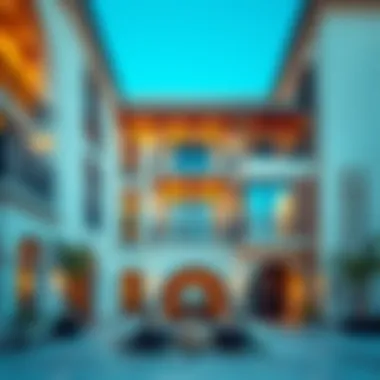

European Influence on Interior Design
The impact of European styles on interior design within Dubai's luxury real estate is nothing short of significant. As Dubai continues to evolve into a global hub, the integration of European aesthetics has elevated the interior spaces to a level of sophistication that speaks to both tradition and modernity. This section delves into the specific elements that characterize European influence in Dubai's interior design, offering insights into the benefits and considerations for expatriates and investors interested in this captivating fusion.
Furnishings and Materials
When it comes to furnishings, European minimalism and elegance shine through in various aspects of Dubai's upscale interior design.
- High-Quality Materials: In many Dubai apartments and villas, you will notice the use of opulent materials often associated with old-world European craftsmanship. Think oak wood furniture and marble floors, which not only add to the aesthetic appeal but also promise durability.
- Design Heritage: Many local designers take cues from Italian and French fashion, blending sleek modern lines with intricate detailing found in antique pieces. This showcases a blend of historical richness and current trends, drawing in buyers looking for depth in their living spaces.
- Comfort Meets Style: Furnishings such as plush sofas, designer chairs, and elegant draping create spaces that are as inviting as they are visually striking. This approach encourages a soft, luxurious ambiance, which reflects a lifestyle that many expatriates seek in Dubai.
Considering these aspects, the importance of selecting the right furnishings is evident. Not only do they enhance the interior but also add long-term value to the property, making it an attractive investment for buyers.
Color Palettes and Textures
When it comes to color palettes, European influence offers a diverse range of options that cater to various aesthetic preferences.
- Neutral Tones: A preference for soft, neutral shades can often be seen. Shades of white, beige, and gray form the backdrop of many interiors. This creates a serene setting, allowing the luxury elements to flourish without overwhelming the senses.
- Bold Accents: While neutrals dominate, vibrant colors like royal blue, deep greens, or rich burgundy are often used to inject personality into spaces. These colors mirror the sophistication found in renowned European cities, and they help in creating an inviting atmosphere.
- Textures Matter: The combination of various textures, such as soft linens, sleek metals, and rich wooden elements, can create a cozy yet opulent feel. This layering approach adds depth and a tactile dimension to interior spaces, captivating the observer’s attention.
Understanding the implications of color and texture in your design approach can be crucial. A well-thought-out palette not only reflects individual taste but also greatly influences how welcoming or expansive a room feels.
The blend of European style with Dubai’s unique attributes leads to interiors that resonate with a global audience, making properties more appealing to potential investors.
Impact on Property Values
The influence of European styles in Dubai's real estate landscape is profound, with far-reaching consequences on property values. If you look closely, the blend of traditional European designs with modern sensibilities creates a unique appeal that has caught the eyes of many investors and homeowners alike. Properties that showcase European architectural elements often command a premium, reflecting not just aesthetic preference but also demand among discerning buyers.
The lavish feel associated with European designs resonates strongly with expatriates and affluent local buyers. When one walks through neighborhoods adorned with these styles, there's an unmistakable allure that seems almost palpable. It's not just about luxury; it's also about making a statement. Living in a property inspired by European architecture often suggests a certain lifestyle, one that is associated with culture and prestige.
Market Trends Analysis
Analyzing current market trends reveals that properties influenced by European styles are more than just eye-candy; they're solid investments. A major factor contributing to this is the rapid urbanization of Dubai, which attracts a continuous influx of migrant populations. Many newcomers, especially Europeans, seek residences that remind them of home. Thus, quite a few developers are specifically crafting projects that integrate European influences, meeting this demand head-on.
Moreover, properties in areas like Dubai Marina and Palm Jumeirah, which are rich with these styles, continue to appreciate in value. According to reports, the properties in Dubai Marina have seen a substantial increase, attributed to their scenic views and luxurious designs. Who would have thought that simple elements like arches or ornamental columns could push property prices up? These influential designs not only enhance visual appeal but also correlate strongly with market performance.
"Properties that reflect European influences are not just homes; they are status symbols in the Dubai real estate market."
It's important to monitor market forecasts and trends consistently. The ongoing developments often align with significant investments from both local and international buyers keen on seizing opportunities while the markets remain buoyant. Keep an eye on emerging neighborhoods where developers are looking to incorporate European architectural styles; they are likely to shape the market in the coming years.
Future Investment Prospects
Looking ahead, the prospects for investments in properties reflecting European styles seem promising. As Dubai aims to position itself as a global hub for culture and tourism, there is no doubt that elegant European designs will play an integral role in the city’s visual narrative. Potential buyers and investors are increasingly recognizing that these properties not only signify historical richness but also a cutting-edge approach to modern living.
A noteworthy consideration is sustainability, which is becoming an essential element of new developments. European architectural practices often emphasize environmentally-friendly design, which is receiving more attention from both buyers and developers. The fusion of style with sustainability can lead to properties that not only appreciate in value but also attract a clientele concerned with ecological considerations.
Additionally, the real estate sector in Dubai is undergoing a transformation, with a push towards more integrated communities that reflect cultural diversity. Investing in properties that embrace European aesthetics provides an avenue to participate in this evolution. As the demand continues to grow, so will property values, positioned advantageously for investors willing to take the leap.
Closure
In examining the intersection of European style with Dubai's architectural and design landscape, several critical insights surface. The implications of these influences extend far beyond aesthetics; they shape perceptions of luxury and cultural value within Dubai's vibrant real estate market.
Summary of Key Insights
Understanding the integration of European style into the fabric of Dubai's neighborhoods is crucial for various stakeholders. Here are some salient points:
- Cultural Fusion: The blend of European design with local elements exemplifies a unique cultural synergy that appeals to diverse demographics. Several residential areas showcase this harmonious balance, drawing buyers from across the globe.
- Investment Opportunities: As European style gains traction, properties designed with these influences often see increased market value. Investors looking to capitalize on this trend benefit from not just a return on investment but also from owning a piece of culturally-rich real estate.
- Sustainable Practices: Many architects and designers are infusing sustainable practices influenced by progressive European design principles. This not only elevates the quality of living but also addresses the growing expectations for environmentally responsible development.
Moreover, it is noteworthy that these European influences are not simply shallow embellishments. They reflect a deeper desire for community engagement, quality craftsmanship, and timeless beauty in urban living spaces.
The Future of European Style in Dubai
Looking ahead, the trajectory of European influences in Dubai's architectural domain seems promising. As the city continues to evolve, several trends are likely to shape the future:
- Increased Demand for Authenticity: Buyers are becoming more discerning, seeking authentic experiences that resonate with their cultural backgrounds. This will lead to a greater emphasis on genuine design elements that reflect European craftsmanship.
- Collaborative Ventures: Expect to see more partnerships between local and European architects. These collaborations often yield innovative projects that blend modern technologies with classic European aesthetics, appealing both to luxury buyers and those with a penchant for tradition.
- Regulatory Changes: With growing awareness of the environmental impacts of construction, regulations might shift to promote designs that emphasize sustainability. This aligns with European standards and practices, which could further boost their influence in Dubai's real estate.



